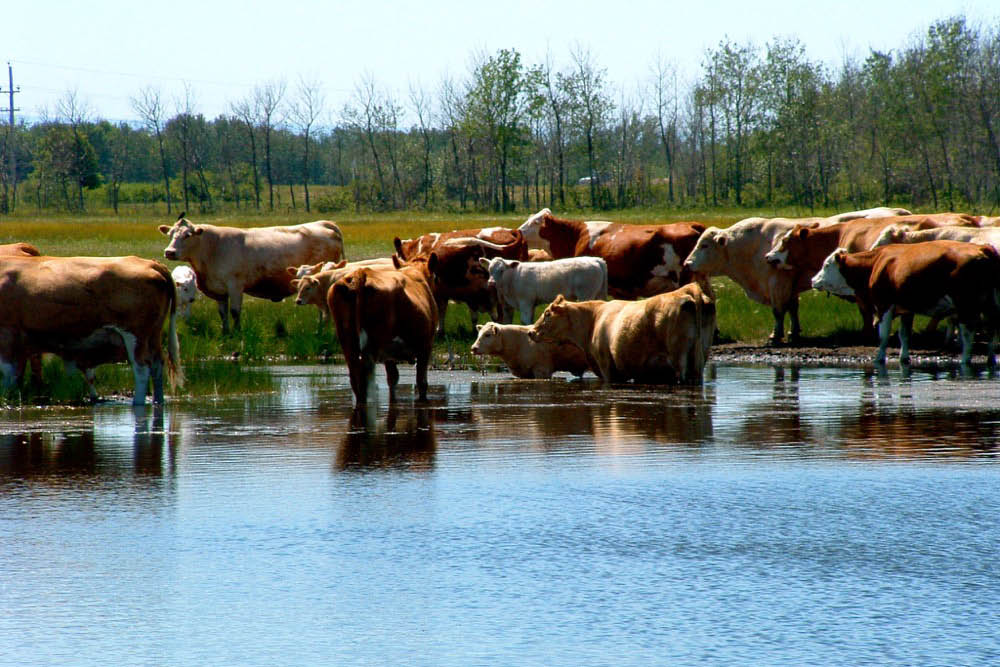Originally published on May 22, 2024 on Manitoba Co-operator
By Jeff Melchior
A new study spearheaded by two University of Manitoba researchers is giving more insight into where nutrients running off into Prairie waterways are coming from, and pasture manure may not be the biggest culprit.
Animal agriculture is often accused of contributing to nutrient load in water bodies like Lake Winnipeg.
The study, led by soil scientist David Lobb and Marcos Cordeiro of the department of animal science, sought to model nitrogen and phosphorus levels in the surface runoff of three watersheds: one each in Alberta, Saskatchewan and Manitoba.
Their model, calibrated to be specific to Western Canada’s conditions, incorporated 15 years of weather data to account for the impacts of precipitation. Statistical analysis allowed researchers to estimate the relative contribution of soil, vegetation and manure to nutrient export. Simulations captured the dynamics in snow accumulation and stream discharge.
Their findings suggested that manure was, at most, a secondary source of nitrogen and phosphorus in those watersheds. They also found that nutrient levels ascribed to manure were relatively constant during the simulation period between 2005 and 2019, despite variation in precipitation.
“This is interesting because, for the most part, we tend to think that beef production is one of the main sources of nutrients,” Cordeiro said.
Of the three nutrient-causing factors, the researchers put manure in third place in Manitoba and second place in the two western Prairie provinces. Manure’s reported contribution to total nutrient export ranged between 7.9-20.2 per cent for total phosphorus and 6.9-11.8 per cent for total nitrogen.
The impact
The Beef Cattle Research Council, which helped fund the project, noted the importance of having accurate models for runoff to help producers better understand how management affects pasture watersheds, as well as what they can do to mitigate nutrient loading.
“It will also give policymakers accurate, Canadian-specific data to use when writing future policies around watershed management,” a BCRC-published summary of the project read.
The BCRC also noted that the regional variation in the findings implies that there’s no one solution for excess nutrient loading. Solutions will have to be region-specific.
Challenges and next steps
Using a model helped save time and money compared to field research, said Cordeiro, whose specialty is environmental modelling.
“The idea for us was to set up a model for a couple of watersheds first and see what the model tells us,” he said. “And then, from there, we can go to more targeted field research where you can monitor (with) a much clearer idea of what you’re trying to assess.”
That field research is the next step in homing in on nutrient sources.
“Rather than starting from scratch having no idea of where the nutrients came from, we now have a good idea,” he said.
The journey, however, hasn’t been without bumps.
Models are only as good as their data. Going in, the researchers knew that all watersheds in the study had a grassland cover proportion of approximately 75 per cent and relatively large cattle-grazing density. However, these pasture areas were not what Cordeiro would describe as “data rich.” The only watershed with stream flow and water quality data was the Alberta location of Meadow Creek. The Manitoba and Saskatchewan watersheds (Beaver Creek and Maple Creek, respectively) lacked this information.
“Agricultural areas are not really well monitored, so we had to select some watersheds that had the best data available … we worked with models and tried to represent them as best as possible. And we feel that we had — given these caveats — a very good result and a handle on at least how this system behaves,” he said.
The Alberta location could be assessed directly with the available information. “The other two were validated using regional data available, water yield, for example, which is less precise,” Cordeiro said.
Eyes on the prize
All of Cordeiro’s grasslands research plays into a goal to preserve landscapes and the ecological goods and services they provide, while also enabling producers to manage those services.
“What we try to show with this research is that these landscapes have value. They provide services that are important for society as a whole,” he said.
“We need to show this value because it’s very romantic to talk about lush landscapes and beautiful scenery, but at the end of the day people have to make a living out of those landscapes.”
The project was funded by the Beef Cattle Research Council, the Canadian Beef Cattle Check-Off and Environment and Climate Change Canada.

